
- Microwave Engineering Tutorial
- Microwave Engineering - Home
- Introduction
- Transmission Lines
- Modes of Propagation
- Types of Transmission Lines
- Waveguides
- Components
- Avalanche Transit Time Devices
- Microwave Devices
- E-Plane Tee
- H-Plane Tee
- E-H Plane Tee
- Rat-race Junction
- Directional Couplers
- Cavity Klystron
- Reflex Klystron
- Travelling Wave Tube
- Magnetrons
- Measurement Devices
- Measurements
- Example Problems
- Microwave Engineering Resources
- Quick Guide
- Microwave Engineering - Resources
- Microwave Engineering - Discussion
Microwave Engineering - Components
In this chapter, we shall discuss about the microwave components such as microwave transistors and different types of diodes.
Microwave Transistors
There is a need to develop special transistors to tolerate the microwave frequencies. Hence for microwave applications, silicon n-p-n transistors that can provide adequate powers at microwave frequencies have been developed. They are with typically 5 watts at a frequency of 3GHz with a gain of 5dB. A cross-sectional view of such a transistor is shown in the following figure.
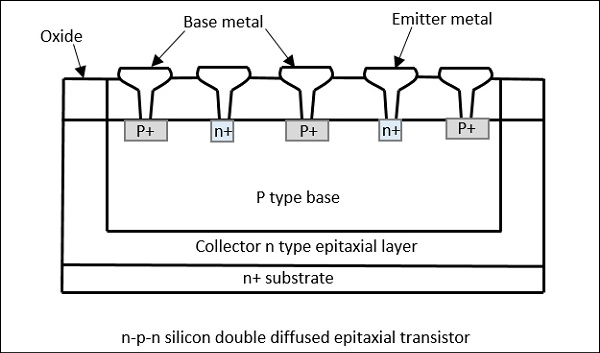
Construction of Microwave Transistors
An n type epitaxial layer is grown on n+ substrate that constitutes the collector. On this n region, a SiO2 layer is grown thermally. A p-base and heavily doped n-emitters are diffused into the base. Openings are made in Oxide for Ohmic contacts. Connections are made in parallel.
Such transistors have a surface geometry categorized as either interdigitated, overlay, or matrix. These forms are shown in the following figure.
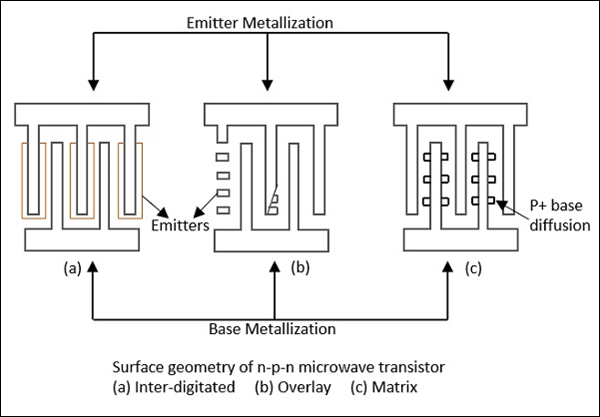
Power transistors employ all the three surface geometries.
Small signal transistors employ interdigitated surface geometry. Interdigitated structure is suitable for small signal applications in the L, S, and C bands.
The matrix geometry is sometimes called mesh or emitter grid. Overlay and Matrix structures are useful as power devices in the UHF and VHF regions.
Operation of Microwave Transistors
In a microwave transistor, initially the emitter-base and collector-base junctions are reverse biased. On the application of a microwave signal, the emitter-base junction becomes forward biased. If a p-n-p transistor is considered, the application of positive peak of signal, forward biases the emitter-base junction, making the holes to drift to the thin negative base. The holes further accelerate to the negative terminal of the bias voltage between the collector and the base terminals. A load connected at the collector, receives a current pulse.
Solid State Devices
The classification of solid state Microwave devices can be done −
Depending upon their electrical behavior
-
Non-linear resistance type.
Example − Varistors (variable resistances)
-
Non-Linear reactance type.
Example − Varactors (variable reactors)
-
Negative resistance type.
Example − Tunnel diode, Impatt diode, Gunn diode
-
Controllable impedance type.
Example − PIN diode
-
- Depending upon their construction
- Point contact diodes
- Schottky barrier diodes
- Metal Oxide Semiconductor devices (MOS)
- Metal insulation devices
The types of diodes which we have mentioned here have many uses such as amplification, detection, power generation, phase shifting, down conversion, up conversion, limiting modulation, switching, etc.
Varactor Diode
A voltage variable capacitance of a reverse biased junction can be termed as a Varactor diode. Varactor diode is a semi-conductor device in which the junction capacitance can be varied as a function of the reverse bias of the diode. The CV characteristics of a typical Varactor diode and its symbols are shown in the following figure.
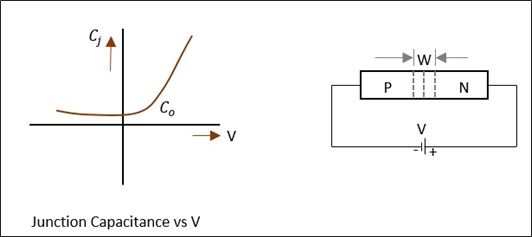
The junction capacitance depends on the applied voltage and junction design. We know that,
$$C_j \: \alpha \: V_{r}^{-n}$$
Where
$C_j$ = Junction capacitance
$V_r$ = Reverse bias voltage
$n$ = A parameter that decides the type of junction
If the junction is reverse biased, the mobile carriers deplete the junction, resulting in some capacitance, where the diode behaves as a capacitor, with the junction acting as a dielectric. The capacitance decreases with the increase in reverse bias.
The encapsulation of diode contains electrical leads which are attached to the semiconductor wafer and a lead attached to the ceramic case. The following figure shows how a microwave Varactor diode looks.
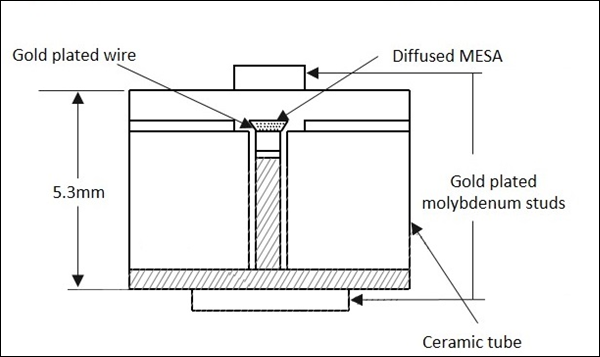
These are capable of handling large powers and large reverse breakdown voltages. These have low noise. Although variation in junction capacitance is an important factor in this diode, parasitic resistances, capacitances, and conductances are associated with every practical diode, which should be kept low.
Applications of Varactor Diode
Varactor diodes are used in the following applications −
- Up conversion
- Parametric amplifier
- Pulse generation
- Pulse shaping
- Switching circuits
- Modulation of microwave signals
Schottky Barrier Diode
This is a simple diode that exhibits non-linear impedance. These diodes are mostly used for microwave detection and mixing.
Construction of Schottky Barrier Diode
A semi-conductor pellet is mounted on a metal base. A spring loaded wire is connected with a sharp point to this silicon pellet. This can be easily mounted into coaxial or waveguide lines. The following figure gives a clear picture of the construction.
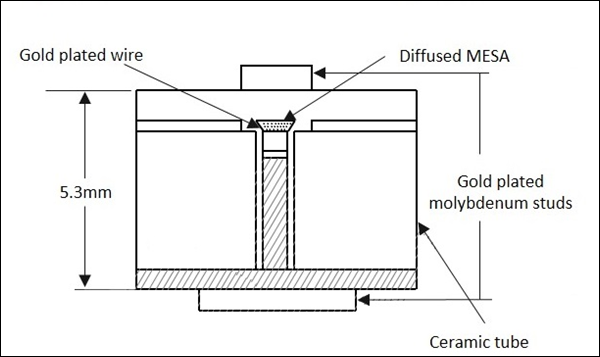
Operation of Schottky Barrier Diode
With the contact between the semi-conductor and the metal, a depletion region is formed. The metal region has smaller depletion width, comparatively. When contact is made, electron flow occurs from the semi-conductor to the metal. This depletion builds up a positive space charge in the semi-conductor and the electric field opposes further flow, which leads to the creation of a barrier at the interface.
During forward bias, the barrier height is reduced and the electrons get injected into the metal, whereas during reverse bias, the barrier height increases and the electron injection almost stops.
Advantages of Schottky Barrier Diode
These are the following advantages.
- Low cost
- Simplicity
- Reliable
- Noise figures 4 to 5dB
Applications of Schottky Barrier Diode
These are the following applications.
- Low noise mixer
- Balanced mixer in continuous wave radar
- Microwave detector
Gunn Effect Devices
J B Gunn discovered periodic fluctuations of current passing through the n-type GaAs specimen when the applied voltage exceeded a certain critical value. In these diodes, there are two valleys, L & U valleys in conduction band and the electron transfer occurs between them, depending upon the applied electric field. This effect of population inversion from lower L-valley to upper U-valley is called Transfer Electron Effect and hence these are called as Transfer Electron Devices (TEDs).
Applications of Gunn Diodes
Gunn diodes are extensively used in the following devices −
- Radar transmitters
- Transponders in air traffic control
- Industrial telemetry systems
- Power oscillators
- Logic circuits
- Broadband linear amplifier